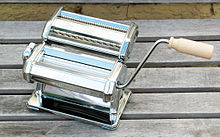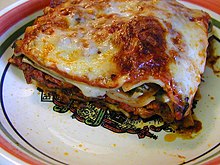Pasta is a staple food of traditional Italian cuisine, now of worldwide renown. It takes the form of an unleavened dough. In Italy, the dough is made mostly from durum wheat or, more rarely,buckwheat flour,[citation needed] with water and, sometimes, eggs. Pasta comes in a variety of different shapes that serve for both decoration and to act as a carrier for the different types of sauce and foods. Pasta also includes varieties, such as ravioli and tortellini, that are filled with other ingredients, such as ground meat or cheese. Pasta is eaten in Italy only as first course or nowadays as "piatto unico".[citation needed]
 There are hundreds of different shapes of pasta with at least locally recognized names.[1]Examples include spaghetti (thin strings), maccheroni (tubes or cylinders), fusilli (swirls), andlasagne (sheets). Gnocchi and spätzle are sometimes considered pasta; they are both traditional in parts of Italy.
There are hundreds of different shapes of pasta with at least locally recognized names.[1]Examples include spaghetti (thin strings), maccheroni (tubes or cylinders), fusilli (swirls), andlasagne (sheets). Gnocchi and spätzle are sometimes considered pasta; they are both traditional in parts of Italy.
Pasta is categorized in two basic styles: dried and fresh. Dried pasta made without eggs can be stored for up to two years under ideal conditions, while fresh pasta will keep for a few days under refrigeration.[2][3] Pasta is generally cooked in boiling water.
Pasta is enriched with iron, folate and several other B-vitamins, including thiamine, riboflavin and niacin. It is even nutritionally enhanced with whole wheat or whole grain or fortified with omega-3 fatty acids and additional fiber. Very low in sodium and cholesterol-free when no eggs are used in some varieties, pasta is low on the Glycemic Index (GI) - which means that they are digested more slowly. Pasta provides a slow release of energy without spiking blood sugar levels. According to the American Pasta Association, enriched pastas provide an excellent source of folic acid and a good source of other essential nutrients, including iron and several B-vitamins. [4] Moreover, some varieties of whole grain pasta can provide up to 25% of daily fiber requirements in every one cup portion.
tymology
First attested in English in 1874, the word pasta comes from Italian pasta, in turn from Latin pasta "dough, pastry cake", itself the latinisationof the Greek παστά (pasta) "barley porridge", in turn from παστός (pastos), "sprinkled with salt, salted".[5][6]
[edit]Ingredients
Under Italian law, dry pasta (pasta asciutta) can only be made from durum wheat flour or durum wheat semolina.[7]Durum flour and durum semolina have a yellow tinge in colour. Italian pasta is traditionally cooked al dente (Italian: lit. "to the tooth", meaning not too soft). Outside Italy, dry pasta is frequently made from other types of flour (such aswheat flour), but this yields a softer product that cannot be cooked al dente the same way. There are many types of wheat flour with varying gluten and protein content depending on variety of grain used.
Particular varieties of pasta may also use other grains and milling methods to make the flour, as specified by Italian law.[7] Some pasta varieties, such as pizzoccheri, are made from buckwheat flour.
Fresh pasta may include eggs (pasta all'uovo 'egg pasta') and in Italy must be made with durum wheat semolina but a maximum of 3% of the cheaper wheat flour is tolerated.[8]
Whole wheat pasta, which generally contains more fibre and more nutrients than refined pasta, has become increasingly popular.[9] Whole wheat pasta designed to appeal to people familiar withrefined grain pastas may have a mixture of whole grain and refined grain ingredients.[10]
[edit]History
In the 1st century BCE writings of Horace, lagana were fine sheets of dough which were fried[12]and were an everyday food.[13] Writing in the 2nd century Athenaeus of Naucratis provides a recipe for lagana which he attributes to the 1st century Chrysippus of Tyana: sheets of dough made of wheat flour and the juice of crushed lettuce, then flavored with spices and deep-fried in oil.[13] An early 5th century cookbook describes a dish called lagana that consisted of layers of dough with meat stuffing, a possible ancestor of modern-day lasagna.[13] However, the method of cooking these sheets of dough does not correspond to our modern definition of either a fresh or dry pasta product, which only had similar basic ingredients and perhaps the shape.[13] The first concrete information concerning pasta products in Italy dates from the 13th or 14th century.[14]
Historians have noted several lexical milestones relevant to pasta, none of which changes these basic characteristics. For example, the works of the 2nd century AD Greek physician Galen mention itrion, homogeneous compounds made up of flour and water.[15] The Jerusalem Talmud records that itrium, a kind of boiled dough,[15] was common in Israel from the 3rd to 5th centuries AD,[16] A dictionary compiled by the 9th century Arab physician and lexicographer Isho bar Ali[17] defines itriyya, the Arabic cognate, as string-like shapes made of semolina and dried before cooking. The geographical text of Muhammad al-Idrisi, compiled for the Norman King of Sicily Roger II in 1154 mentionsitriyya manufactured and exported from Norman Sicily:
"West of Termini there is a delightful settlement called Trabia.[18] Its ever-flowing streams propel a number of mills. Here there are huge buildings in the countryside where they make vast quantities of itriyya which is exported everywhere: to Calabria, to Muslim and Christian countries. Very many shiploads are sent."[19]
Itriyya gives rise to trie in Italian, signifying long strips such as tagliatelle and trenette. One form of itriyya with a long history is laganum(plural lagana), which in Latin refers to a thin sheet of dough,[13] and gives rise to Italian lasagna.
According to historians like Charles Perry, the Arabs adapted noodles for long journeys in the 5th century, the first written record of dry pasta. Durum wheat pasta was introduced by Libyian Arabs during their conquest of Sicily in the late 7th century[14]
In North Africa, a food similar to pasta, known as couscous, has been eaten for centuries. However, it lacks the distinguishing malleable nature of pasta, couscous being more akin to droplets of dough. At first, dry pasta was a luxury item in Italy because of high labor costs, durum wheat semolina had to be kneaded for a long time. Only after the industrial revolution in Naples, when a mechanical die process allowed for large scale production of dry pasta, did it become affordable and popular among the common people.[citation needed]
There is a legend of Marco Polo importing pasta from China[20] which originated with the Macaroni Journal, published by an association of food industries with the goal of promoting the use of pasta in the United States.[21] Marco Polo describes a food similar to "lagana" in his Travels, but he uses a term with which he was already familiar.
[edit]Varieties
See also: list of pasta
[edit]Accompaniments
Pasta is generally served with some type of sauce; the sauce and the type of pasta are usually matched based on consistency and ease of eating. Northern Italian cooking uses less tomato sauce, garlic and herbs. In Northern Italy white sauce is more common.[22] However Italian cuisine is best identified by individual regions. Pasta dishes that incorporate lighter cooked tomato are found in Trentino-Alto Adige and Emilia Romagna.[23][24][25] In Bologna, the meat basedBolognese sauce incorporates a small amount of tomato concentrate and a green sauce calledpesto originates from Genoa. In Central Italy, there are sauces such as tomato sauce,amatriciana, arrabiata and the egg based carbonara.
Tomato sauces are also present in Southern Italian cuisine, where they originated. In Southern Italy more complex variations include pasta paired with fresh vegetables, olives, capers or seafood. Varieties include puttanesca, pasta alla norma (tomatoes, eggplant and fresh or baked cheese),pasta con le sarde (fresh sardines, pine nuts, fennel and olive oil), spaghetti aglio, olio e peperoncino (literally with garlic, [olive] oil and hot chili peppers).
Fettuccine alfredo with cream, cheese and butter, and spaghetti with tomato sauce (with or without meat) are popular Italian-style dishes in the United States.
[edit]International adaptations
As pasta was introduced elsewhere in the world, it became incorporated into a number of local cuisines, which often have significantly different ways of preparation from those of Italy. In Hong Kong, the local Chinese have adopted pasta, primarily spaghetti and macaroni, as an ingredient in the Hong Kong-style Western cuisine.
In Cha chaan teng (茶餐廳), macaroni is cooked in water and served in broth with ham orfrankfurter sausages, peas, black mushrooms, and optionally eggs, reminiscent of noodle soupdishes. This is often a course for breakfast or light lunch fare.[26] These affordable dining shops evolved from American food rations after World War II due to lack of supplies, and they continue to be popular for people with modest means so any comparison to Italy or Hong Kong's more authentic Italian eateries is irrelevant.
Two common spaghetti dishes served in Japan are the Bolognese (ミートソース) and theNapolitan (ナポリタン). In India, macaroni has been adopted and cooked in an Indianized way. Boiled macaroni is sautéed along with cumin, turmeric, finely chopped green chillies, onions & cabbage. In Greece hilopittes is considered one of the finest types of dried egg pasta. It is cooked either in tomato sauce or with various kinds of casserole meat. It is usually served with Greek cheese of any type.
Pasta is also widespread in Argentina and Brazil, especially in the areas with strong Italian roots, like Buenos Aires and São Paulo. The local names for the pasta are varieties of the Italian names, such as ñoquis/nhoque for gnocchi, ravioles/ravióli for ravioli, or tallarines/talharim for tagliatelle. In Sweden, spaghetti is traditionally served with köttfärssås (Bolognese sauce), which is minced meat in a thick tomato soup. In the Philippines, spaghetti is often served with a distinct, slightly sweet yet flavorful meat sauce, frequently containing diced hot dogs. InMalta, baked pasta is commonly served.
















Tidak ada komentar:
Posting Komentar